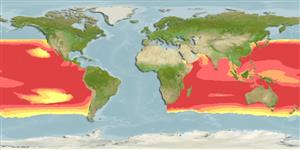Environment: milieu / Zona climática / intervalo de profundidade / distribution range
Ecologia
marinhas pelagic-oceanic; oceanódromo (Ref. 51243); intervalo de profundidade 0 - 1830 m (Ref. 86942), usually 0 - 350 m (Ref. 89423). Subtropical; 43°N - 56°S, 20°E - 68°W
Indian and Pacific: tropical and temperate waters. Although some stray individuals are found in the Atlantic Ocean, this species is believed to have its spawning grounds and principal populations only in the Pacific and Indian Oceans. Highly migratory species.
Tamanho / Peso / Idade
Maturidade: Lm ? range ? - ? cm
Max length : 230 cm TL macho/indeterminado; (Ref. 9308); common length : 190 cm TL macho/indeterminado; (Ref. 9308); peso máx. publicado: 52.0 kg (Ref. 43)
Espinhos dorsais (total) : 0; Raios dorsais (total) : 51 - 57; Espinhos anais: 0; Raios anais : 18 - 23. Dark blue above, blue splattered with brown on the sides, silvery white below; 1st dorsal fin plain dark blue, other fins brown or dark brown; anal fin bases with tinges of silvery white.
Body shape (shape guide): elongated.
Oceanic and epipelagic, found above the thermocline (Ref. 9308). Feeds on fishes, cephalopods and crustaceans. Also caught as a by-catch of long lines with hooks intended for tuna. Marketed frozen and prepared as fish cakes and sashimi in Japan (Ref. 9308). Also prepared as sausages.
Ciclo de vida ou comportamento de acasalamento
Maturidade | Reprodução | Desova | Ovos | Fecundidade | Larvas
Spawning is believed to occur mainly during the winter months, especially in warm offshore currents with surface temperature of about 25°C.
Nakamura, I., 1985. FAO species catalogue. Vol. 5. Billfishes of the world. An annotated and illustrated catalogue of marlins, sailfishes, spearfishes and swordfishes known to date. FAO Fish. Synop. 125(5):65p. Rome: FAO. (Ref. 43)
Status na Lista Vermelha da UICN (Ref. 130435: Version 2024-2)
Ameaça para os humanos
Harmless
Uso pelos humanos
Pescarias: pouco comercial; peixe esportivo: sim
Ferramentas
Relatórios especiais
Baixar XML
Fontes da internet
Estimates based on models
Preferred temperature (Ref.
123201): 13.9 - 28.8, mean 26.2 °C (based on 5116 cells).
Índice de diversidade filogenética (Ref.
82804): PD
50 = 0.5630 [Uniqueness, from 0.5 = low to 2.0 = high].
Bayesian length-weight: a=0.00457 (0.00227 - 0.00920), b=3.21 (3.02 - 3.40), in cm total length, based on LWR estimates for this species & (Sub)family-body (Ref.
93245).
Nível Trófico (Ref.
69278): 4.5 ±0.76 se; based on food items.
Resiliência (Ref.
120179): médio(a), tempo mínimo de duplicação da população 1,4 - 4,4 anos (Assuming tm=2-4).
Fishing Vulnerability (Ref.
59153): Very high vulnerability (90 of 100).
🛈
Climate Vulnerability (Ref.
125649): Moderate vulnerability (45 of 100).
🛈
Nutrients (Ref.
124155): Calcium = 35.6 [15.9, 65.1] mg/100g; Iron = 1.07 [0.56, 2.01] mg/100g; Protein = 19.6 [18.3, 20.8] %; Omega3 = 0.296 [0.155, 0.612] g/100g; Selenium = 69.5 [32.9, 148.9] μg/100g; VitaminA = 5.16 [1.47, 18.59] μg/100g; Zinc = 0.345 [0.222, 0.536] mg/100g (wet weight);
